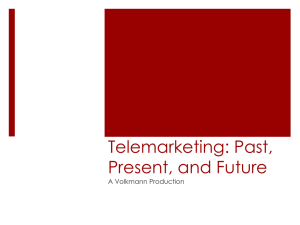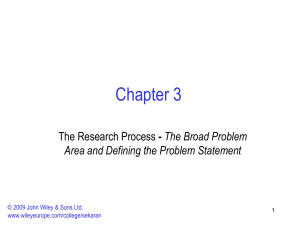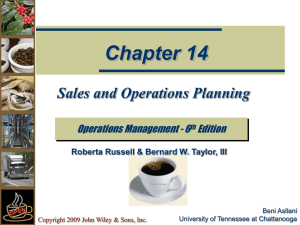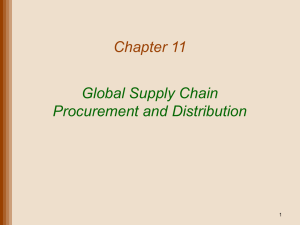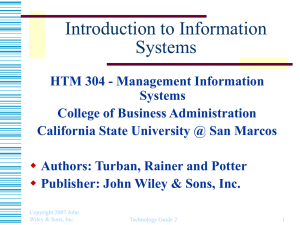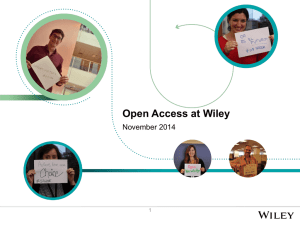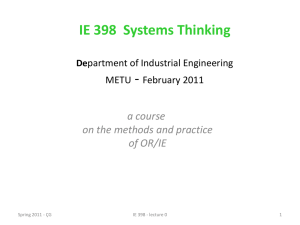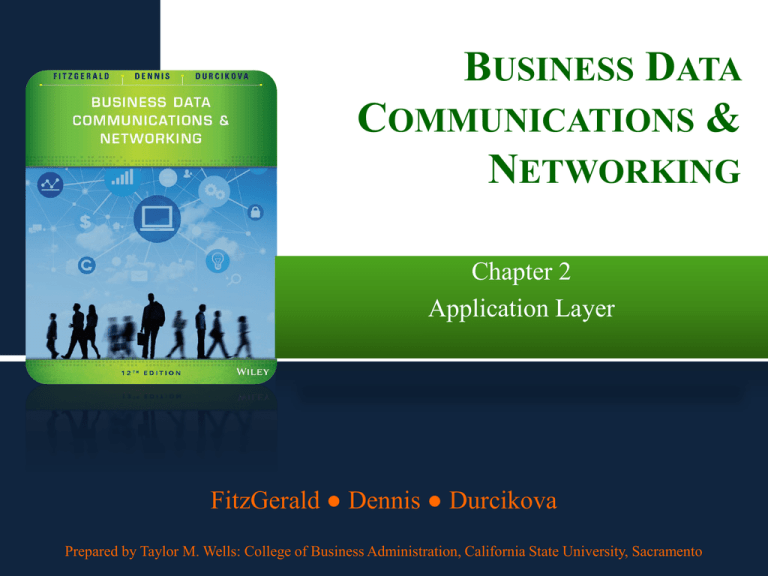
BUSINESS DATA
COMMUNICATIONS &
NETWORKING
Chapter 2
Application Layer
FitzGerald ● Dennis ● Durcikova
Prepared by Taylor M. Wells: College of Business Administration, California State University, Sacramento
Copyright © 2015 John Wiley & Sons, Inc. All rights reserved.
Outline
•
•
•
•
•
Application Architectures
The Web
Email
Other Application-Layer Protocols
Implications for Management
Copyright © 2015 John Wiley & Sons, Inc. All rights reserved.
Application Layer
Internet Model
• Layer 5 in the Internet model
• The software that enables
users to interact with the
network and accomplish tasks
Application
Transport
Network
Data Link
Physical
Copyright © 2015 John Wiley & Sons, Inc. All rights reserved.
Application Architecture
• The way the functions of the application layer are spread
out across the client and server
• Four components of applications:
1. Presentation logic
2. Application logic
3. Data access logic
4. Data Storage
Copyright © 2015 John Wiley & Sons, Inc. All rights reserved.
Host-Based Architecture
• Server contains all components (“server-based”)
• Common in the 1960s with mainframes and terminals
CLIENT
SERVER
Presentation Logic
Application Logic
Data Access Logic
Data Storage
Copyright © 2015 John Wiley & Sons, Inc. All rights reserved.
Host-Based Architecture
• Advantages
– Very simple
– Single point of control
• Disadvantages
– Host (server) can become a bottleneck
– Upgrades typically expensive
Copyright © 2015 John Wiley & Sons, Inc. All rights reserved.
Client-Based Architecture
• Client contains presentation, application, and data access
logic
• Most common in the 1980s
CLIENT
Presentation Logic
Application Logic
Data Access Logic
SERVER
Data Storage
Copyright © 2015 John Wiley & Sons, Inc. All rights reserved.
Client-Based Architecture
• Advantages
– Hardware and applications less expensive
– Simple architecture
• Disadvantages
– Data must travel back and forth between server and
client
Copyright © 2015 John Wiley & Sons, Inc. All rights reserved.
Client-Server Architecture
• Most common architecture today
CLIENT
SERVER
OR
Presentation Logic
Application Logic
Application Logic
Data Access Logic
Data Storage
Copyright © 2015 John Wiley & Sons, Inc. All rights reserved.
Client-Server Architecture
• Thin clients are easier to manage, thick clients have more
functionality
Thick-Client Architecture
CLIENT
Presentation Logic
Application Logic
SERVER
Data Access Logic
Data Storage
Thin-Client Architecture
CLIENT
Presentation Logic
Copyright © 2015 John Wiley & Sons, Inc. All rights reserved.
SERVER
Application Logic
Data Access Logic
Data Storage
Client-Server Architecture
• Advantages
– More efficient because of distributed processing
– Allows hardware/software from different vendors to be
used together
– Less bandwidth required
• Disadvantages
– May be challenges in configuring hardware/software
from different vendors to work together
– In many cases, middleware is required
Copyright © 2015 John Wiley & Sons, Inc. All rights reserved.
Client-Server Architecture
• Middleware is software acts as an intermediary by “sitting
between” client and server applications
• Provides a standard way of translating between software from
different vendors
• Manages message transfers
• Insulates network changes from the clients (e.g., adding a
new server)
Client
Applications
Middleware
Copyright © 2015 John Wiley & Sons, Inc. All rights reserved.
Server
Applications
Client-Server Architecture
two-tier
n-tier architecture
• Example of three-tier
CLIENT
Presentation Logic
Application
Web
SERVER
SERVER
Application
Database
SERVER
Application
Application Logic Data
Access Logic
Data Access Logic Data Storage
Data Storage
Copyright © 2015 John Wiley & Sons, Inc. All rights reserved.
Database
SERVER
Data Access Logic
Data Storage
Tiered Client-Server Architecture
• Advantages
– Load balancing
– More scalable
• Disadvantages
– Each tier increases network load
– More complex and difficult to develop applications
Copyright © 2015 John Wiley & Sons, Inc. All rights reserved.
Peer-to-Peer Architecture
• An older architecture that became popular again with
Napster, BitTorrent, etc.
• All devices can act as client and server
CLIENT/SERVER
CLIENT/SERVER
Presentation Logic
Application Logic
Data Access Logic
Data Storage
Presentation Logic
Application Logic
Data Access Logic
Data Storage
Copyright © 2015 John Wiley & Sons, Inc. All rights reserved.
Peer-to-Peer Architecture
• Advantages
– Resilient to failure
– Data can be stored anywhere on network
– Distributes bandwidth requirements
• Disadvantages
– Finding the stored data
– Security
Copyright © 2015 John Wiley & Sons, Inc. All rights reserved.
Cloud Computing
• Cloud Computing is the general term for enabling access
to computing services over the network (most commonly
the Internet)
• Models of cloud computing define who manages each
application function and associated hardware/software
Copyright © 2015 John Wiley & Sons, Inc. All rights reserved.
Cloud Computing
• Cloud Computing Models
– Software as a Service (SaaS)
• All application components and associated
hardware/software outsourced
• Based on multitenancy
• e.g. Salesforce.com
– Platform as a Service (PaaS)
• Application logic and data are managed internally
• e.g., Microsoft Azure
– Infrastructure as a Service (IaaS)
• All hardware is outsourced
Copyright © 2015 John Wiley & Sons, Inc. All rights reserved.
Cloud Computing
Traditional Thin-Client
Client-Server
Internal
Outsourced
Infrastructure as a
Service (IaaS)
Internal
Outsourced
Platform as a Service
(Paas)
Software as a Service
(SaaS)
Internal
Internal
Outsourced
Outsourced
Application
Logic
X
X
X
X
Data Storage
X
X
X
X
Data Access
Logic
X
X
X
X
Operating
System
X
X
X
X
Virtualization
Software
X
X
X
X
Server
Hardware
X
X
X
X
Storage
Hardware
X
X
X
X
Network
Hardware
X
X
X
X
Copyright © 2015 John Wiley & Sons, Inc. All rights reserved.
Criteria for Choosing Architecture
• Infrastructure
– Cost of servers, clients, and circuits
– Reliability
• Development Costs
– Software; cheaper on host-based architectures
• Scalability
– Ability to increase (or decrease) in computing capacity
as network demand changes
– Easier in client-server architectures
Copyright © 2015 John Wiley & Sons, Inc. All rights reserved.
The Web
• Hypertext Transfer Protocol (HTTP)
• HTTP Request and Response
Client
computer
with Web
browser
software
HTTP
Response
Web Server
HTTP
Request
Copyright © 2015 John Wiley & Sons, Inc. All rights reserved.
The Web
• HTTP Request
Copyright © 2015 John Wiley & Sons, Inc. All rights reserved.
The Web
• HTTP Response
Copyright © 2015 John Wiley & Sons, Inc. All rights reserved.
Email
• Mail Transfer Agent (MTA)
– Formal name for mail server software
– e.g., Sendmail, Postfix,
• Mail User Agent (MUA)
– Formal name for mail client software
– e.g., Outlook, Apple Mail, Thunderbird
• Simple Mail Transfer Protocol (SMTP)
– Protocol used to send a message to a MTA
– Originally only handled text files
• Internet Message Access Protocol (IMAP) or Post Office Protocol
(POP)
– Protocols used by a MUA to retrieve messages from an MTA
• American Standard Code for Information Interchange (ASCII)
– A standard for encoding text characters (a-z, A-Z, 0-9, a few symbols)
Copyright © 2015 John Wiley & Sons, Inc. All rights reserved.
Email
Copyright © 2015 John Wiley & Sons, Inc. All rights reserved.
Email
•
•
•
•
•
How a message is sent (2-tier, thick client)
Sending Client → Sender’s Mail Server (SMTP)
Sender’s Mail Server → Receiver’s Mail Server (SMTP)
Message waits on Receiver’s Mail Server in “mailbox”
Receiving Client → Receiver’s Mail Server (IMAP or
POP)
• Receiver’s Mail Server → Receiving Client (IMAP or
POP)
Copyright © 2015 John Wiley & Sons, Inc. All rights reserved.
Email
Copyright © 2015 John Wiley & Sons, Inc. All rights reserved.
Email
• How a message is sent via webmail (3-tier, thin client)
1. Sending Client → Sender’s Web Server (HTTP)
2. Sender’s Web Server → Sender’s Mail Server (SMTP)
3. Sender’s Mail Server → Receiver’s Mail Server (SMTP)
4. Mail waits on Receiver’s Mail Server in “mailbox”
5. Receiving Client → Receiver’s Web Server (HTTP)
6. Receiver’s Web Server → Receiver’s Mail Server (IMAP
or POP)
7. Receiver’s Mail Server → Receiver’s Web Server (IMAP
or POP)
8. Receiver’s Web Server → Receiving Client (HTTP)
Copyright © 2015 John Wiley & Sons, Inc. All rights reserved.
Email
• SMTP Message Format
– RFC 822: Standard for text
message format
• Header lines
– Contain information about the
message such as To, From, and
Subject
• Body section
– Contains the “content of the
message
– Begins with the “DATA”
keyword
– Only uses ASCII characters
Copyright © 2015 John Wiley & Sons, Inc. All rights reserved.
Header
Body
Email
• Inside an SMTP packet
– Header: source, destination, date, subject, etc.
– Body: keyword “DATA”, then email message
Copyright © 2015 John Wiley & Sons, Inc. All rights reserved.
Email
• SMTP is a simple protocol to send plain text
• Not designed to send images or attachments
• Multipurpose Internet Mail Extension (MIME)
– A standard to extend support for attachments and nonASCII characters in email
– Used by sender to convert (encode) any non-ASCII
content into ASCII
– Receivers then convert (decode) the ASCII back to its
original format
Copyright © 2015 John Wiley & Sons, Inc. All rights reserved.
Other Application-Layer Protocols
• File Transfer Protocol (FTP) - for moving files between
clients and servers
• Telnet, Secure Shell (SSH) - for executing commands on
a remote system
• Internet Relay Chat (IRC), Extensible Messaging and
Presence Protocol (XMPP) - for real-time text chat
(instant messaging)
• Domain Name System (DNS) - for mapping domain
names to IP addresses
Copyright © 2015 John Wiley & Sons, Inc. All rights reserved.
Instant Messaging
Copyright © 2015 John Wiley & Sons, Inc. All rights reserved.
Video Conferencing
Copyright © 2015 John Wiley & Sons, Inc. All rights reserved.
Implications for Management
• Primary purpose of networks is to provide environment
for applications
• The number and types of applications on the network is
dramatically increasing
Copyright © 2015 John Wiley & Sons, Inc. All rights reserved.


